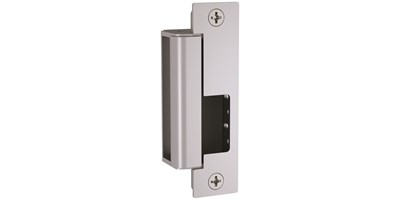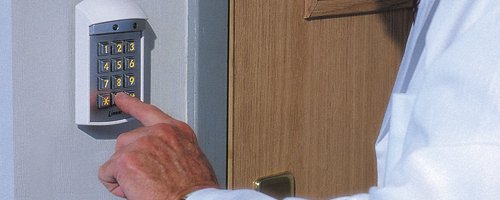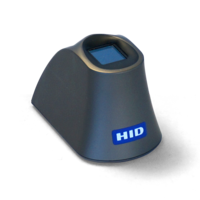Awhile back, we created a post to help you with Securing Your Most Important Doors. In that post, we discuss the idea of installing an access control system to both control and track access to your business’s most important doors. This unique security offering gives customers a tremendous amount of options for creating this security. In this post, we explain your access control installation options to help you discover an option that works best for your application.
We’ll start this discussion with an explanation of how we install access control systems and what they do. After all, knowing your installation options only helps if you have the basics under your belt first! From there, we’ll explain the door hardware we use to allow us to create an access control system. We have a couple options for hardware installation based on the doors you wish to connect to access control. From there, we’ll share your options for access readers. We often surprise our customers with the range of access control reader options that we offer. Therefore, knowing and understanding your options will help you choose the best equipment for your own property. Now, let’s get started with an overview of access control before jumping into detailed descriptions of access control components.
Your Access Control Primer
Over the past several years, access control systems have gotten increasingly popular. This security measure involves using advanced lock equipment to control access to your property. Access control systems utilize electronic locking hardware to operate specific doors within a business. Rather than using a key at these doors, users approach a keypad or a reader and present either a code or a physical credential. We’ll get into the specifics regarding these options a little later. Users who present an approved credential will then be able to open the door after the reader interacts with the door’s electronics to unlock it. Business owners can assign each credential to open only certain doors at specific times, giving them tremendous control over who can open which doors, and when.
In addition to controlling access to certain doors, access control systems include software that tracks access as well! Every time an employee approaches an access door, it creates a time-stamped event that you can view on a computer by logging in to your access control system. This allows you to easily track employee activity within your business. Furthermore, it allows you to see if anyone tries to enter doors in your business that they should not attempt to enter.
For example, if an employee without the necessary permission attempts to enter a secure room, the system will both deny access and “flag” this event. At that point, you will know which employee attempted this breach. The security and flexibility offered by these systems makes them an extremely valuable piece of any commercial security plan. Now, let’s get deeper into our access control installation options, starting with the door hardware we use when installing this security.

An electric strike, such as the HES model shown here, electronically unlatches when the proper access control credentials are presented.
Door Hardware Options
As we mentioned earlier, access control systems use electronic hardware that activates when prompted by a credential, rather than a key. Therefore, we must run wiring from a power supply to each door to supply the electricity these systems need. From there, we connect our door hardware to power. We’ll explain that last step in our next section. Here, we’ll go over the most common types of lock hardware we use to unlock our access doors. In many cases, we utilize exit devices (or “crash bars”) that include electronics built right into them! We can do this by ordering a “fresh” crash bar with electrified latch retraction. Additionally, we can often install electronic retrofit kits inside of an existing crash bar. This allows us to avoid replacing existing, high-quality lock equipment.
For doors with standard levers, we often install electric strikes, such as the one pictured above. These devices unlatch electronically upon a user presenting a proper code or physical credential. Finally, we can also install mag locks for applications with double doors. In this case, the “mag” stands for “magnet.” These devices hold the double doors shut with a heavy-duty magnet installed on the top of the frame. The magnet releases the doors to allow the proper users through. Additionally, we must also tie these doors into a property’s fire alarm and install other fire-safety equipment to ensure doors to not stay stuck during a fire. For this reason, mag locks represent a more expensive solution than either electronic crash bars or electric strikes. Now, let’s explore our options for access control keypads, readers, and credentials.
Selecting the Keypads, Readers, and Credentials that Work for You
As with door hardware, we offer some variety when it comes to installing access control keypads and readers. Additionally, one of these devices, our proximity readers, can read multiple types of physical credentials. In this section, we’ll look at a few different types of technology we use to create additional door security. We’ll start with basic keypad-based access control. From there, we’ll look at our proximity readers, our most popular access reader option. Finally, we’ll see how installing biometric readers can add security — as well as extra expense and potentially headaches! Let’s dive in with the most “basic” access control option.
Keypad-Based Access Control
Keypads provide a basic additional level of security to a business. Installing a keypad limits door access to those who know one of the user codes that will unlock the door. This level of simplicity does come with its setbacks. After all, anybody who knows an access code to a building can get through a keypad. For this reason, installing a keypad will provide less security than installing one of our other reader options.

Keypads, such as this Linear option, allow users to enter a code to unlock access control doors.
However, keypad systems often cost less than their reader-based counterparts. Security companies can often install keypad locks or deadbolts without tying them into a controller or adding electronic elements to an existing door. You can often even buy a battery-operated keypad and skip installing additional electronic equipment altogether. Both of these options make it possible to install keypads at a much smaller cost than other types of access control.
Of course, skipping these steps limits a keypad’s use. Some battery-operated keypads will allow any user code to work at all times. Therefore, a code that works during the work week will work after hours or on a weekend. Furthermore, a self-contained keypad will not track access or if it does, it can take quite a bit of work and programming to access the data. If an employee steals from a business over the weekend, that business owner may have difficulty seeing who came in, and when. Next up, let’s look at a type of access control reader that provides a bit more security.
Standard Proximity Readers
Proximity readers get their name from the fact that they read a card or fob that enters the proximity of the reader itself. These readers represent the most popular type of access control readers we install. As with most commercial security options, proximity readers have both pros and cons. On the plus side, proximity readers present a good mix of both security and affordability. Unlike keypads, proximity readers require a very specific credential to allow access to a door.
The biggest downfall to a proximity system lies in the use of cards and fobs that can get lost or, in extreme cases, copied or “cloned.” If an employee loses a proximity device, that provides a security risk until someone finds the credential or deletes it from the system. “Cloning” a proximity card or fob involves copying the data from a proximity device and copying it onto another device. In this case, a reader will not generally know the difference between the original credential and the new, “copied” card or fob. Not all cards can be cloned, but the more secure a card is, the more it will cost. To combat this risk, many readers now allow for bluetooth-enabled access! Since people do not often lose their smartphones for long periods of time, this feature can provide extra security. Now, let’s look at one of our more secure — but less popular — access control installation options.

Some customers prefer installing biometric readers, such as this fingerprint reader by HID, rather than proximity readers.
Biometric Readers
Biometric readers allow users to enter a door based on a biometric feature such as a fingerprint, handprint, or even an eye scan. These readers are great for high-security areas. After all, users cannot steal (or lose) credentials the way they could lose cards or fobs. Likewise, potential thieves cannot clone a biometric feature. However, these types of readers do have their downfalls. This type of reader is the most sensitive, and also requires the most maintenance. After time, dirt, dust, or other residue may build up on the surface of the reader. When this happens, the system may deny access even to authorized employees. Similarly, even brief exposure to sunlight or rain can make it difficult for your reader to work properly in outdoor settings.
Choosing Wisely from Your Access Control Installation Options
We hope that this post has helped you understand your access control installation options. Moreover, we encourage you to contact us with any questions that you may have. We’ve helped numerous customers with the design and installation of access control systems that provide priceless security. Furthermore, we also encourage you to take advantage of our free site survey program. We offer free consulting for access control systems to both new and existing customers alike. While on site, we can address any access-based security concerns you may have. Additionally, we can make our own suggestions based on our observations while on site. Together, we can create an efficient and effective solution to both control and track access to your property’s most important doors.
